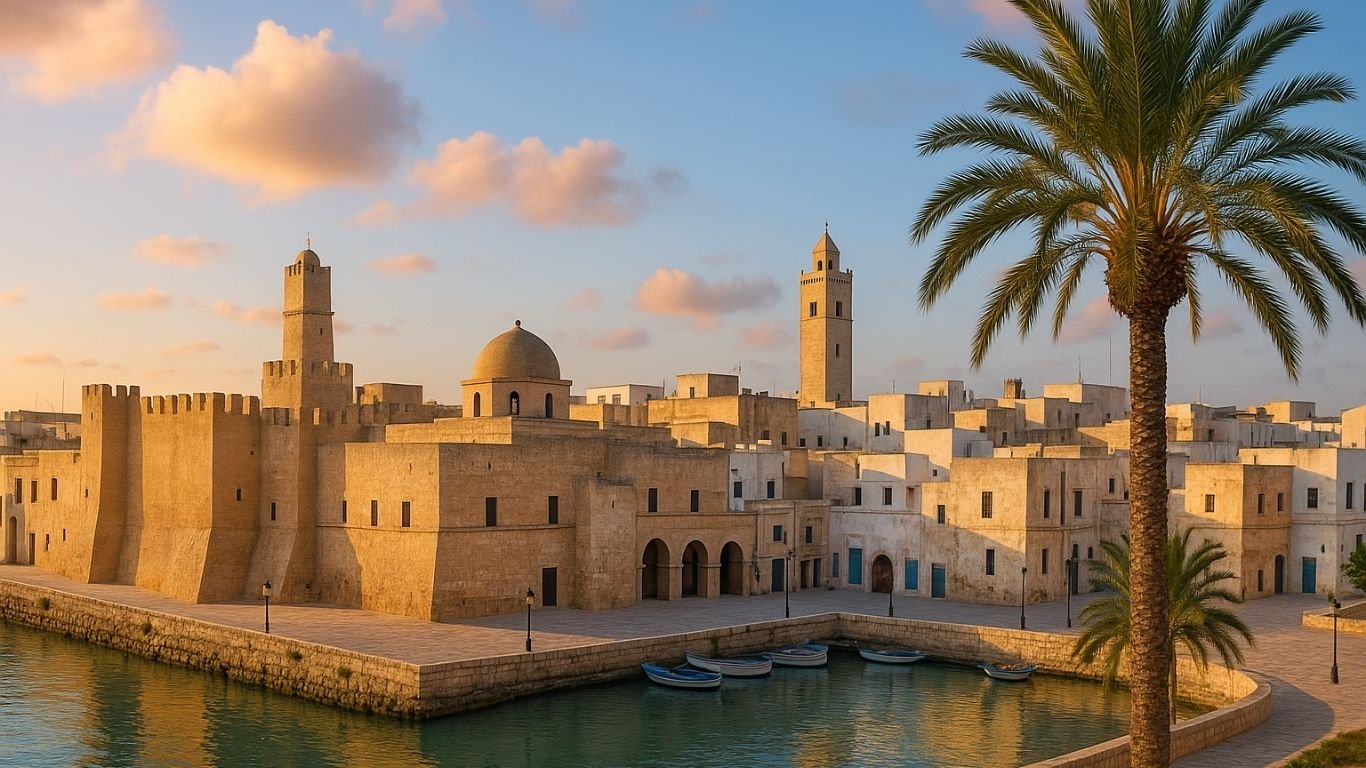Tunisia is a land of contrasts—where sun-soaked beaches meet ancient ruins, and bustling medinas give way to vast Saharan landscapes. Whether you’re drawn to the historical significance of cities like Kairouan and Sfax or the coastal relaxation of Hammamet and Djerba, Tunisia offers travelers a rich palette of experiences. The country’s diverse heritage, shaped by Berber, Arab, Ottoman, and French influences, is visible in its architecture, cuisine, and cultural rituals.
This guide explores the best cities to visit in Tunisia, highlighting destinations that blend historical depth, natural beauty, and local charm. From the capital’s lively souks to desert outposts carved from stone, each city offers its own story. Whether you’re a first-time visitor or returning for a deeper journey, these ten cities showcase why Tunisia remains a treasure waiting to be discovered.
Table of Contents
1. Tunis

History and Culture
Tunis, the dynamic capital of Tunisia, stands as a powerful blend of antiquity and modernity. From the labyrinthine alleys of the UNESCO-listed Medina to the sleek avenues of Ville Nouvelle, Tunis captures the country’s soul in every step. Once a Phoenician settlement and later a thriving Roman outpost under Carthaginian rule, Tunis has absorbed centuries of history, religion, and trade into its cultural DNA.
French colonial architecture frames its boulevards, while traditional souks buzz with artisanal life, reflecting Tunisia’s vibrant heritage. Museums such as the Bardo offer insight into millennia of Mediterranean history, while the call to prayer rising above whitewashed minarets grounds visitors in the city’s deep Islamic identity. It’s this rich, multifaceted past—combined with a fast-evolving present—that makes Tunis one of the best cities to visit in Tunisia.
Must-See Attractions
Uncover iconic landmarks and cultural marvels that affirm Tunis as one of the best cities to visit in Tunisia:
- Medina of Tunis: A UNESCO World Heritage Site filled with narrow alleys, historic mosques, and colorful souks brimming with leather goods, carpets, and spices.
- Bardo National Museum: Houses one of the world’s most significant collections of Roman mosaics and artifacts from Tunisia’s diverse civilizations.
- Avenue Habib Bourguiba: The city’s French-colonial-era spine, lined with cafes, shops, and theatres—Tunis’s version of the Champs-Élysées.
- Zitouna Mosque: One of North Africa’s oldest mosques, this spiritual and academic center has shaped Islamic scholarship for over a millennium.
- Carthage Ruins: Just outside the city, these ancient remains reveal the splendor of one of Rome’s greatest rivals, with Roman villas, baths, and a massive amphitheater.
Unique Experiences
| Experience Type | Description |
|---|---|
| Souk Shopping | Browse for handcrafted ceramics, silver jewelry, and aromatic spices in the Medina’s centuries-old markets. |
| Historical Immersion | Walk through ancient Carthage’s ruined basilicas and Roman theaters by the sea. |
| Cultural Contrast | Experience the divide between old-world souks and the chic cafés of modern Tunis. |
| Religious Heritage | Visit the Zitouna Mosque and learn about Islamic architecture and philosophy. |
Best Time to Visit & Transportation
The best time to visit Tunis is in spring (March to May) or autumn (September to November), when temperatures are comfortable and the city comes alive with festivals and open-air events. Summers can be quite hot but offer fewer crowds for sightseeing.
Tunis-Carthage International Airport serves as the main air hub for the country and connects easily to the city center by taxi, bus, or light rail. Public transportation within Tunis includes metro light rail (Métro léger), buses, and shared taxis (louages), making it a convenient city to navigate.
2. Sousse
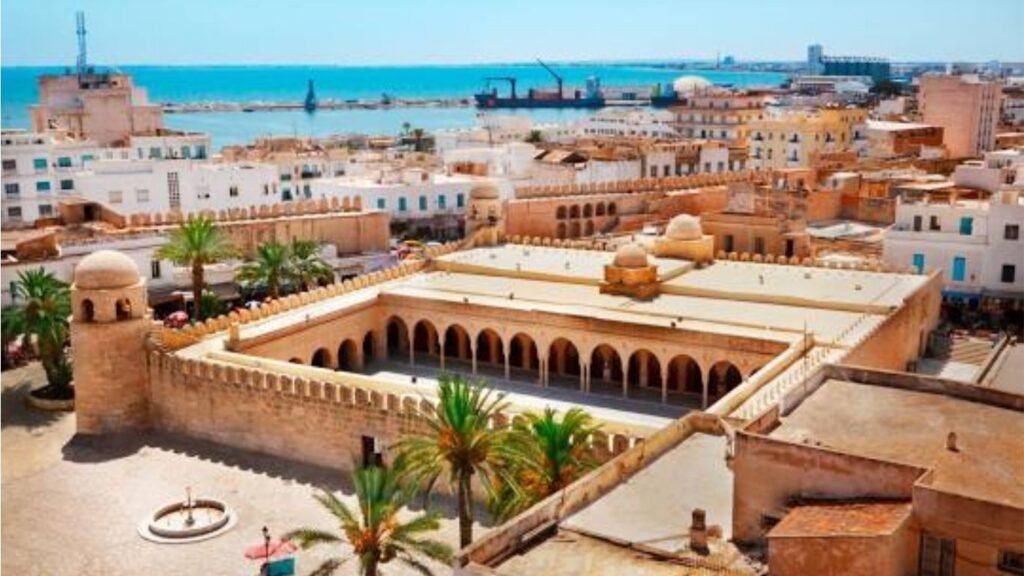
History and Culture
Sousse is a coastal gem that harmonizes Tunisia’s seafaring heritage with Islamic tradition. As one of the oldest cities on the Mediterranean, Sousse was a key trade center under Phoenician, Roman, and later Islamic rule. The city’s robust fortifications and medina architecture reflect centuries of strategic importance. Its UNESCO-listed Medina stands as one of the best-preserved examples of North African Islamic cities.
Beyond its historic heart, Sousse boasts long sandy beaches, resort-lined promenades, and a vibrant nightlife scene that keeps visitors engaged beyond the ancient walls. This perfect blend of beachside leisure and cultural richness makes Sousse one of the best cities to visit in Tunisia for travelers seeking both relaxation and authenticity.
Must-See Attractions
Explore the coastal attractions and cultural treasures that make Sousse one of the best cities to visit in Tunisia:
- Medina of Sousse: A UNESCO World Heritage Site, filled with narrow lanes, traditional souks, and centuries-old architecture.
- Ribat of Sousse: This fortified Islamic monastery offers panoramic views over the old city and sea.
- Sousse Archaeological Museum: Located inside the Kasbah, it houses mosaics and Roman-era relics rivaling those of the Bardo Museum.
- Bou Jaafar Beach: Popular for sunbathing and water sports, the beachfront stretches along the heart of the city.
- Port El Kantaoui: A modern marina and resort complex just north of Sousse, known for its yacht-filled harbor, restaurants, and golf courses.
Unique Experiences
| Experience Type | Description |
|---|---|
| Historical Forts | Climb the Ribat for views of the Mediterranean and the Medina rooftops. |
| Market Life | Shop for textiles, pottery, and dried fruits in the lively souks. |
| Coastal Leisure | Relax on sandy beaches or take a boat trip from Port El Kantaoui. |
| Cultural Discovery | Visit ancient tombs and Roman villas tucked into the city’s museums. |
Best Time to Visit & Transportation
The ideal time to visit Sousse is from April to June and September to October, when the climate is mild and the sea is warm enough for swimming. Summer months attract the most tourists but can be hot and crowded.
Sousse is easily accessible via domestic rail lines and well-connected highways. The city lies on the main Tunis-Sfax railway and is serviced by fast trains and shared taxis. For air travel, the nearest airport is Monastir Habib Bourguiba International, just 20 minutes away by car or local train.
3. Djerba

History and Culture
Djerba, the largest island off North Africa’s coast, offers a distinctive blend of Mediterranean charm, Berber heritage, and Jewish history. Famed in ancient legends as the land of the lotus-eaters in Homer’s Odyssey, Djerba’s story spans thousands of years—from Phoenician traders to Roman settlers and Islamic dynasties. White-domed houses, palm-lined streets, and centuries-old synagogues define its unique architectural and cultural identity.
The island’s relaxed pace and open skies have long attracted artists, historians, and spiritual seekers. From the traditional pottery village of Guellala to the intricately painted El Ghriba Synagogue, Djerba is a destination rich in identity. Its cultural depth and coastal beauty make it one of the best cities to visit in Tunisia for those wanting something off the typical tourist trail.
Must-See Attractions
Discover why Djerba is considered one of the best cities to visit in Tunisia through its eclectic sights and immersive experiences:
- Houmt Souk: The island’s capital town, filled with artisan markets, whitewashed buildings, and historic fortresses.
- El Ghriba Synagogue: One of the oldest synagogues in Africa, this pilgrimage site is an enduring symbol of Jewish life in Tunisia.
- Guellala Museum: Showcases local pottery traditions, folklore, and island heritage through interactive exhibits.
- Djerba Explore Park: Combines cultural museums with a crocodile farm, offering fun and education for all ages.
- Beaches of Sidi Mahrez & Seguia: Known for their turquoise waters and peaceful sands, perfect for sunseekers and swimmers.
Unique Experiences
| Experience Type | Description |
|---|---|
| Spiritual Exploration | Visit El Ghriba Synagogue during the annual Jewish pilgrimage. |
| Artisan Workshops | Watch traditional ceramic techniques in Guellala’s pottery ateliers. |
| Island Cycling | Rent a bike and explore palm groves, beaches, and rural villages. |
| Cultural Fusion | Enjoy Djerba’s unique mix of Arab, Berber, and Jewish influences. |
Best Time to Visit & Transportation
The best time to explore Djerba is from April to early June and September to November, when temperatures are warm but not extreme. Summer is ideal for beach holidays, though it draws more crowds and higher prices.
Djerba–Zarzis International Airport connects the island with major cities in Tunisia and Europe. A causeway links Djerba to the mainland, and local buses, taxis, and louages make moving around the island easy and affordable. Ferries also operate to and from Ajim for a more scenic arrival.
4. Sfax

History and Culture
Sfax is Tunisia’s industrial and commercial powerhouse, yet it retains a strong sense of tradition and authenticity. Founded on the ruins of ancient Taparura, the city rose to prominence during the Aghlabid dynasty in the 9th century. Unlike more touristy destinations, Sfax offers a true glimpse into Tunisian daily life, untouched by heavy tourism but rich in heritage and culture.
Its walled Medina remains one of the most intact in the country, and its blend of Arab-Islamic architecture and bustling trade networks give it a distinctive character. For travelers seeking depth over polish, Sfax provides an experience rooted in reality, making it one of the best cities to visit in Tunisia for cultural purists and history lovers.
Must-See Attractions
Explore Sfax’s enduring landmarks and vibrant urban life to see why it ranks among the best cities to visit in Tunisia:
- Medina of Sfax: Enclosed by robust ramparts, this old city teems with markets, mosques, and traditional workshops.
- Dar Jellouli Museum: Located inside a historic home, this museum offers insight into local arts, crafts, and daily life.
- Bab Diwan Gate: The iconic entrance to the Medina, featuring classic Islamic architectural motifs.
- Kasbah of Sfax: A seaside fortress offering panoramic views and an on-site museum detailing regional history.
- Thyna Archaeological Site: Ancient Roman ruins just outside the city, including baths and necropolises.
Unique Experiences
| Experience Type | Description |
|---|---|
| Medina Immersion | Navigate the active souks and interact with artisans in an authentic setting. |
| Historical Walks | Visit Roman ruins in Thyna and Ottoman-era mosques inside the Medina. |
| Culinary Traditions | Try Sfaxian couscous and seafood dishes prepared with unique local flavors. |
| Coastal Exploration | Walk the seaside promenades that trace the city’s maritime roots. |
Best Time to Visit & Transportation
The best time to visit Sfax is in spring (March to May) or autumn (October to November), when temperatures are mild and ideal for walking tours. Summers can be hot, but the sea breeze offers some relief.
Sfax–Thyna International Airport connects the city to Tunis and other domestic hubs. Trains and buses make overland travel easy, while the local louage system ensures quick connections to neighboring towns. Within the city, taxis and shared minibuses provide reliable transportation.
5. Kairouan
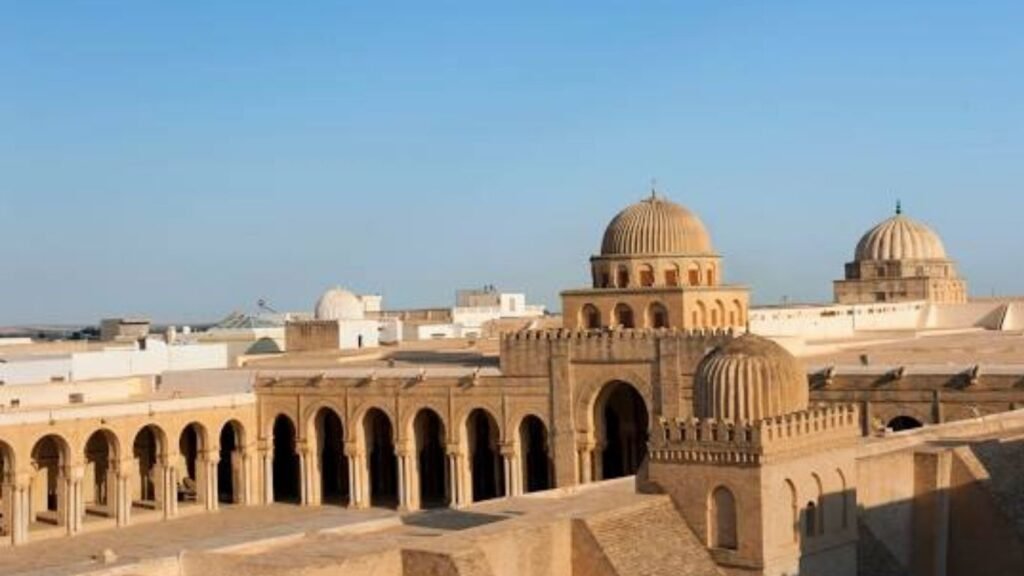
History and Culture
Kairouan holds a sacred place in North Africa’s spiritual and architectural history. Founded in the 7th century, it is considered the fourth holiest city in Islam and the first Islamic settlement in the Maghreb. With its soaring minarets, arched alleyways, and timeless craftsmanship, Kairouan is a living museum of Islamic art and devotion.
The city’s significance is enshrined in its grand mosque, intricate medina, and centuries-old water systems. Recognized by UNESCO, Kairouan’s historic center is a masterpiece of Maghrebi architecture and cultural continuity. Its deep-rooted traditions and religious aura make it one of the best cities to visit in Tunisia for those seeking a profound cultural and spiritual experience.
Must-See Attractions
Explore why Kairouan stands out as one of the best cities to visit in Tunisia through its monuments and sacred spaces:
- Great Mosque of Kairouan: One of the oldest and most important mosques in the Islamic world, dating back to 670 AD.
- Medina of Kairouan: A maze of narrow streets, whitewashed houses, and craft shops filled with carpets and copperware.
- Aghlabid Basins: Ingenious 9th-century waterworks that once supplied the entire city and reflect advanced medieval engineering.
- Barber’s Mosque (Zaouia of Sidi Sahab): A sacred mausoleum blending Islamic architecture with decorative tile work.
- Souks of Kairouan: Known especially for handmade carpets and traditional sweets like makroudh.
Unique Experiences
| Experience Type | Description |
|---|---|
| Spiritual Pilgrimage | Visit the Great Mosque and feel the historic gravity of early Islamic worship. |
| Artisan Shopping | Purchase world-renowned Kairouan carpets woven with centuries-old techniques. |
| Architectural Touring | Explore ancient mosques, cisterns, and alleyways that tell the city’s story. |
| Culinary Sampling | Taste local delicacies like makroudh, a semolina pastry filled with dates. |
Best Time to Visit & Transportation
The ideal time to visit Kairouan is during spring (March to May) or autumn (September to November), when the weather is comfortable and suitable for exploring the medina and mosques on foot. Summers are dry and can be very hot.
Kairouan is well-connected by road from Tunis, Sousse, and Sfax via frequent bus and louage services. Though it lacks an airport or train station, the city’s compact size allows easy exploration on foot or by taxi. Visiting Kairouan offers a seamless and immersive experience, making it one of the best cities to visit in Tunisia for travelers with an eye for heritage and authenticity.
6. Hammamet
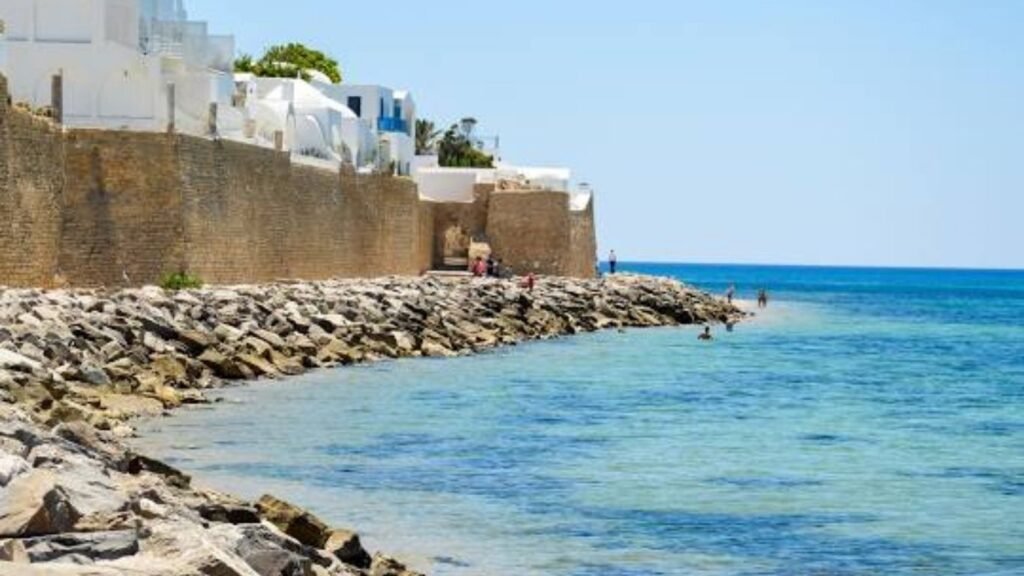
History and Culture
Hammamet, often referred to as Tunisia’s original beach resort, is a coastal city where turquoise waters meet centuries of cultural charm. Originally a quiet fishing village, Hammamet has grown into a vibrant destination known for its whitewashed buildings, jasmine-scented streets, and blend of Andalusian, Arabic, and French influences. With a fortified Medina perched above the sea and a history dating back to Roman times, Hammamet offers much more than sun and sand.
While modern resorts line its beaches, the city’s heart still beats within its traditional souks and centuries-old kasbah. The tranquil beauty and historical ambiance make Hammamet one of the best cities to visit in Tunisia for those wanting a seamless mix of leisure, culture, and charm.
Must-See Attractions
From coastal views to cultural landmarks, Hammamet deserves its place among the best cities to visit in Tunisia:
- Hammamet Medina: Enclosed by thick ramparts, the old town features narrow alleys, artisan shops, and seaside cafés.
- Kasbah of Hammamet: A 15th-century fortress offering sweeping views of the Mediterranean and a small museum.
- Dar Sebastian: A luxurious villa-turned-cultural center that showcases architecture, art, and performances.
- Yasmine Hammamet: A modern resort district with a marina, amusement park, and long stretches of beach.
- International Cultural Centre: Hosts festivals, concerts, and exhibitions in a setting of lush gardens and sea breezes.
Unique Experiences
| Experience Type | Description |
|---|---|
| Beachfront Relaxation | Enjoy pristine sandy beaches and swim in the calm, blue waters of the Gulf of Hammamet. |
| Cultural Events | Attend summer festivals and performances at Dar Sebastian or the cultural centre. |
| Historical Strolling | Wander through the Medina’s arched alleys and discover hidden artisan corners. |
| Spa and Wellness | Indulge in thalassotherapy and traditional hammams in the city’s renowned spas. |
Best Time to Visit & Transportation
The best time to visit Hammamet is from May to early July or September to October, when the weather is warm but the crowds are lighter than in peak summer. Spring also brings blooming gardens and cultural festivals.
Hammamet is conveniently located between Tunis and Sousse and is well-served by the A1 highway and train lines. Buses and louages run frequently, and the city is just over an hour’s drive from Tunis-Carthage International Airport. Getting around locally is easy with taxis and hotel shuttles.
With its Mediterranean charm and relaxed atmosphere, Hammamet continues to shine as one of the best cities to visit in Tunisia for both cultural travelers and beach lovers.
7. Tozeur

History and Culture
Tozeur is an oasis city that rises dramatically from the edge of the Sahara Desert. Known for its lush date palm groves, mud-brick architecture, and deep ties to Berber and Islamic traditions, Tozeur has long been a cultural and economic hub in southern Tunisia. Historically positioned on ancient caravan routes, it played a pivotal role in trade between North Africa and sub-Saharan regions.
Its old quarter, Ouled el Hadef, is famous for intricate brickwork patterns unique to the region, and its religious schools (zawiyas) reflect centuries of scholarship. With its mix of desert mystique and historical depth, Tozeur stands out as one of the best cities to visit in Tunisia for travelers seeking an immersive experience far from the coast.
Must-See Attractions
Venture into a different side of Tunisia by exploring why Tozeur ranks among the best cities to visit in Tunisia:
- Medina of Tozeur (Ouled el Hadef): A historic district filled with ornate brick facades and winding alleys.
- Chott el Jerid: A vast salt lake with mirage-like landscapes, often visited at sunrise or sunset for surreal views.
- Dar Cheraït Museum: Offers insights into traditional Tunisian life through art, antiques, and architectural displays.
- Nefta Oasis: A nearby town famed for its natural spring and Sufi heritage, just a short drive from Tozeur.
- Star Wars Filming Sites: Nearby desert sets from the original Star Wars films offer a pop culture twist to your desert adventure.
Unique Experiences
| Experience Type | Description |
|---|---|
| Desert Safari | Ride camels or 4x4s across sand dunes to discover palm-filled oases and Berber camps. |
| Architectural Marvels | Admire the geometric designs of traditional Tozeur brickwork. |
| Cultural Heritage | Visit local museums and religious schools to understand Saharan spiritual life. |
| Salt Lake Exploration | Witness the surreal beauty of Chott el Jerid and its optical illusions. |
Best Time to Visit & Transportation
The best time to visit Tozeur is from October to April, when desert temperatures are pleasant and ideal for outdoor exploration. Summer months can be extremely hot, making sightseeing difficult during midday.
Tozeur–Nefta International Airport connects the city to Tunis and other domestic destinations. Regular buses and louages link Tozeur with major cities like Gafsa and Kairouan. Within the city, taxis and rental bikes make it easy to explore both the modern areas and the historic medina.
For those drawn to desert landscapes, ancient culture, and hidden cinematic gems, Tozeur remains one of the best cities to visit in Tunisia.
8. Monastir
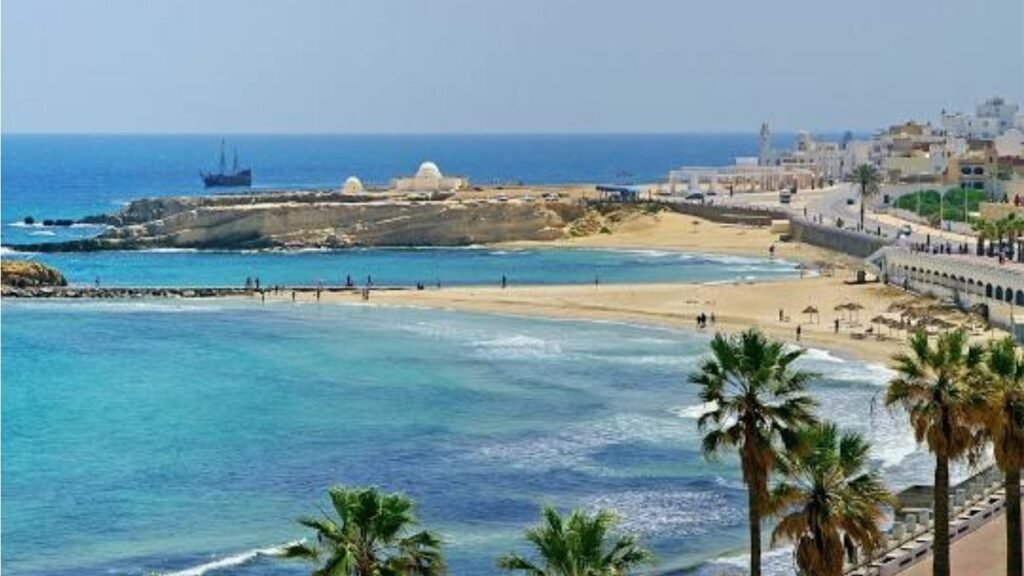
History and Culture
Monastir is a coastal city steeped in Islamic heritage and Tunisian national pride. Once a Phoenician trading post, it rose to prominence during the Islamic conquest and later became the birthplace of Tunisia’s first president, Habib Bourguiba. Overlooking the Mediterranean, Monastir combines ancient history with a clean, modern resort town atmosphere.
The city’s impressive Ribat, one of the oldest defensive fortresses in North Africa, stands as a symbol of its religious and military importance. At the same time, its palm-lined boulevards, museums, and pristine beaches make it an inviting destination for all kinds of travelers. This unique duality places Monastir firmly among the best cities to visit in Tunisia.
Must-See Attractions
Monastir is packed with sights that highlight why it’s considered one of the best cities to visit in Tunisia:
- Ribat of Monastir: A massive seaside fortress with panoramic views, often used as a film location.
- Bourguiba Mausoleum: A monumental tribute to Tunisia’s first president, set within serene gardens.
- Monastir Marina: A scenic waterfront lined with cafés, boutiques, and fishing boats.
- Habib Bourguiba Museum: Displays the personal artifacts and history of Tunisia’s founding father.
- Skanes Beach: A popular coastal stretch ideal for sunbathing and water sports, located just outside the city center.
Unique Experiences
| Experience Type | Description |
|---|---|
| Historical Fortresses | Climb the Ribat’s towers for dramatic views of the sea and cityscape. |
| National Pride | Visit Bourguiba’s mausoleum to explore modern Tunisia’s roots. |
| Coastal Leisure | Enjoy beachfront resorts, stroll the marina, or take a boat excursion. |
| Cultural Immersion | Explore Islamic architecture and heritage without the heavy tourist crowds. |
Best Time to Visit & Transportation
The best time to visit Monastir is from April to June and September to October, when temperatures are pleasant and perfect for exploring historic sites and relaxing on the beach.
Monastir Habib Bourguiba International Airport is located just minutes from the city and provides direct access to both domestic and international destinations. Trains and buses connect Monastir with nearby cities such as Sousse and Mahdia. Within the city, taxis and local buses are inexpensive and reliable, making it easy to move between attractions.
For travelers who want coastal beauty, national history, and spiritual landmarks in one destination, Monastir remains one of the best cities to visit in Tunisia.
9. Matmata
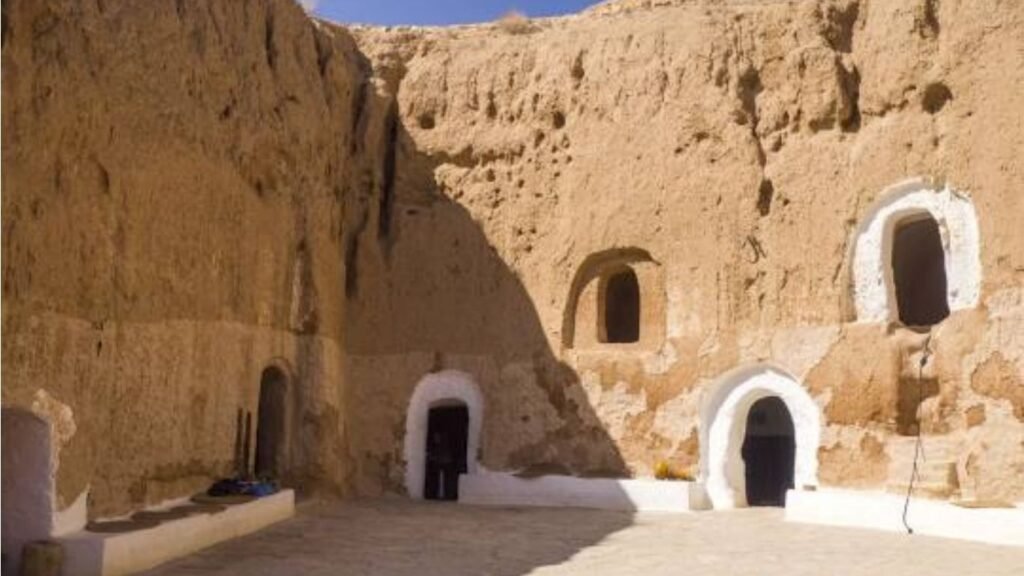
History and Culture
Matmata is one of Tunisia’s most surreal and culturally unique destinations, known for its underground troglodyte dwellings carved into the earth. Inhabited by Berber communities for centuries, these subterranean homes were originally designed to provide natural insulation against the harsh desert climate. The town’s distinctive architecture and way of life offer an authentic glimpse into indigenous heritage.
Though small in size, Matmata has gained international fame thanks to its striking appearance—most notably featured as Luke Skywalker’s home in the original Star Wars film. This blend of cultural authenticity and cinematic fame has secured Matmata’s place among the best cities to visit in Tunisia, especially for travelers seeking something entirely different.
Must-See Attractions
From earth-carved homes to cinematic legends, Matmata offers some of the most unusual reasons it’s among the best cities to visit in Tunisia:
- Troglodyte Homes: Visit traditional Berber underground houses, many of which are still inhabited and open to tourists.
- Hotel Sidi Driss: The real-world filming location of Luke Skywalker’s home in Star Wars: A New Hope.
- Matmata Museum: Showcases local traditions, tools, and lifestyle of the indigenous Berber population.
- Tamezret Village: A nearby mountain village that offers panoramic views and an authentic Berber atmosphere.
- Rock Formations: Surrounding desert landscapes are perfect for scenic photography and peaceful walks.
Unique Experiences
| Experience Type | Description |
|---|---|
| Underground Living | Tour subterranean homes to understand how locals adapted to desert extremes. |
| Movie Tourism | Walk through Star Wars sets and relive cinematic history in a real-world setting. |
| Cultural Storytelling | Engage with local Berber families and hear tales passed through generations. |
| Desert Tranquility | Explore the surrounding arid hills and enjoy silence under wide Saharan skies. |
Best Time to Visit & Transportation
The best time to visit Matmata is during spring (March to May) and autumn (October to November), when desert temperatures are manageable and skies are crystal clear. Summers can be extremely hot and are best avoided for midday exploration.
Matmata is accessible by road from Gabès or Douz via well-maintained routes. The nearest transport hub is Gabès, which has a train station and domestic airport. Louages (shared taxis) frequently connect Matmata with nearby towns. Once in the village, most attractions can be reached on foot or via local guides.
As one of the best cities to visit in Tunisia for cultural immersion and unusual landscapes, Matmata delivers a travel experience unlike any other.
10. Bizerte
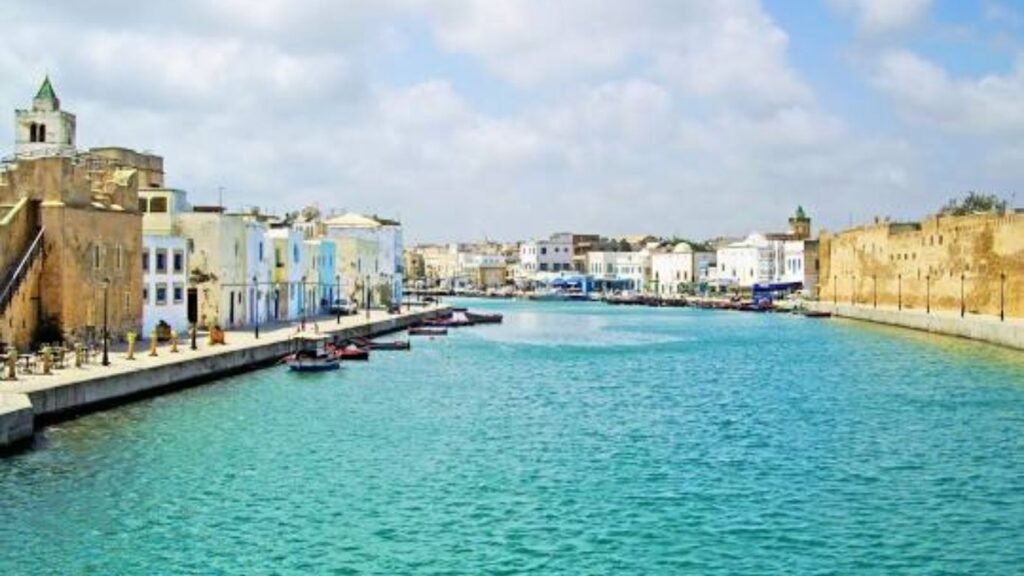
History and Culture
Bizerte is Tunisia’s northernmost city, where Mediterranean charm meets centuries of strategic maritime history. Often overlooked in favor of more popular coastal destinations, Bizerte offers a quiet, authentic experience steeped in Phoenician, Roman, Arab, and French colonial heritage. Its location between sea and lake has made it a naval stronghold for centuries, while its vibrant old port and relaxed vibe make it a hidden treasure for visitors.
With its whitewashed architecture, fortress walls, and proximity to unspoiled beaches, Bizerte seamlessly combines history and nature. Its genuine atmosphere, away from mass tourism, makes it one of the best cities to visit in Tunisia for those seeking an off-the-beaten-path coastal experience.
Must-See Attractions
Discover the cultural and coastal gems that make Bizerte one of the best cities to visit in Tunisia:
- Old Port (Vieux Port): A picturesque harbor surrounded by colorful boats, arched bridges, and local cafés.
- Kasbah of Bizerte: A historic fortress offering views of the port and glimpses into Ottoman-era architecture.
- Oceanographic Museum: Housed in a 17th-century fort, this museum explores marine life and Tunisia’s fishing traditions.
- Ichkeul National Park: A UNESCO-listed wetland just south of the city, home to migratory birds and rare wildlife.
- Cap Blanc: The northernmost point of Africa, with stunning cliffside views and clear waters.
Unique Experiences
| Experience Type | Description |
|---|---|
| Seaside Exploration | Stroll the Vieux Port and enjoy fresh seafood with a view of fishing boats. |
| Historical Discovery | Climb the Kasbah walls for panoramic views of Bizerte’s medina and coastline. |
| Wildlife Excursions | Visit Ichkeul National Park for birdwatching and ecological exploration. |
| Scenic Drives | Take a road trip along Cap Blanc for views of cliffs meeting the sea. |
Best Time to Visit & Transportation
The best time to visit Bizerte is from April to June and September to early November, when the coastal weather is pleasant and perfect for outdoor adventures. Summers are warmer and busier but remain a good option for beachgoers.
Bizerte is easily accessible from Tunis, just 60 kilometers away by highway or train. Shared taxis and buses run frequently between the two cities. Once in Bizerte, taxis and walking are the most practical ways to explore its compact historic areas and scenic coastline.
For travelers looking to enjoy history, nature, and serenity away from the crowds, Bizerte confidently holds its place among the best cities to visit in Tunisia.
FAQ: Best Cities to Visit in Tunisia
What is the best time to visit Tunisia?
The best time to visit Tunisia is during the spring (March to May) and autumn (September to November). These seasons offer comfortable temperatures for sightseeing, beach outings, and desert adventures.
Is Tunisia safe for tourists?
Yes, Tunisia is generally safe for tourists, especially in well-visited cities. As with any destination, it’s recommended to stay informed about local conditions and follow common travel safety practices.
How many days do I need to explore the best cities to visit in Tunisia?
To fully enjoy the best cities to visit in Tunisia, a 10–14 day itinerary is ideal. This allows time to explore both coastal destinations and inland historical sites without rushing.
Do I need a visa to travel to Tunisia?
Citizens of many countries, including the EU, US, and Canada, can enter Tunisia without a visa for stays up to 90 days. Always check updated visa requirements based on your nationality before traveling.
What languages are spoken in Tunisia?
Arabic is the official language, but French is widely spoken, especially in urban areas. English is becoming more common in tourist zones and among younger Tunisians.
Tourism in Tunisia – Wikipedia